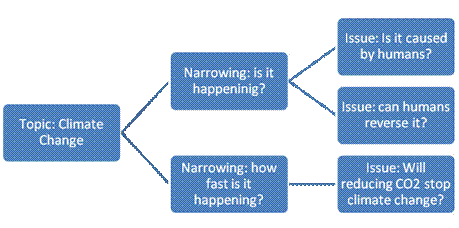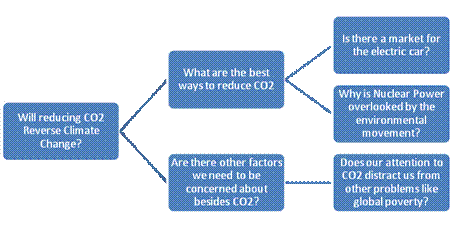Day 16 (Tuesday, October 6th)
Lesson Objectives
Students will
Activities
Attendance and introduction (2-3 minutes)
Narrowing Lecture & Exercise (10 minutes)
Students will have difficulty coming up with an inquiry question. Reviewing the difference between topics and issues will be helpful here. Use the following overhead to review and get students thinking about what topic group they might fall under.
Topics: The following are topics covered in the rhetoric of green inquiry. |
Issues: Within our rhetoric of green |
Environment and ecoliteracy |
Issues: |
Human thinking and human capacity |
Issues: |
Fresh water |
Issues: |
Oceans |
Issues: |
Air pollution |
Issues: |
Forests and lands |
Issues: |
Species & biodiversity |
Issues: |
Human health |
Issues: |
Environmental justice |
Issues: |
Civil society civilizations collapse |
Issues: |
OIL |
Issues: |
Economy and corporations |
Issues: |
Consumers and media |
Issues: |
Sustainable design |
Issues: |
Renewable energy |
Issues: |
Solutions from nature |
Issues: |
Individual action |
Issues: |
Other topics? |
|
On the board create the following narrowing tree, using the rhetoric of green example or one of your own. Have the students continue to narrow the question until they are asking questions that are specific, narrow, current and debatable.
Topic Narrowing Issues Issues

Narrowing Further Narrowing Further Inquiry Question

Write-to-Learn (10 minutes)
Have students write about their initial ideas for inquiry. They may write in paragraph form or try their hand at their own narrowing tree, like the one above. What are the topics they are thinking of working with for a sustained inquiry? What are the issues within said topic? What inquiry questions can be narrowed from the topic’s issues?
Getting into Groups (10-15 Minutes)
Have students choose their inquiry question and then decide which topic they feel their inquiry question belongs under. Write the topic headings on the board with room to put students’ names and questions alongside the headings.
Topics: The following are topics covered in the rhetoric of green inquiry. |
Inquiry Questions: |
Environment and ecoliteracy |
|
Human thinking and human capacity |
|
Fresh water |
|
Oceans |
|
Air pollution |
|
Forests and lands |
|
Species & biodiversity |
|
Human health |
|
Environmental justice |
|
Civil society civilizations collapse |
|
OIL |
|
Economy and corporations |
|
Consumers and media |
|
Sustainable design |
|
Renewable energy |
|
Solutions from nature |
|
Individual action |
|
Other topics? |
|
You may need to take some liberties in order to ensure a manageable number of groups, and a balanced number of members between groups.
Review Assignment 3 (5-10 minutes)
You might use some of the strategies for introducing assignments that you used successfully in phase 1, or you might try something different. Either way, make sure that students are becoming comfortable with the goals and objectives for Assignment 3.
Explain reasons for annotated bibliography and introduce basic research strategies (5-10 minutes)
Why should I write an annotated bibliography?
To learn about your topic: Writing an annotated bibliography is excellent preparation for a research project. Just collecting sources for a bibliography is useful, but when you have to write annotations for each source, you're forced to read each source more carefully. You begin to read more critically instead of just collecting information. At the professional level, annotated bibliographies allow you to see what has been done in the literature and where your own research or scholarship can fit.
To help you formulate a thesis: Every good research paper is an argument. The purpose of research is to state and support a thesis. So a very important part of research is developing a thesis that is debatable, interesting, and current. Writing an annotated bibliography can help you gain a good perspective on what is being said about your topic. By reading and responding to a variety of sources on a topic, you'll start to see what the issues are, what people are arguing about, and you'll then be able to develop your own point of view.
To help other researchers: Extensive and scholarly annotated bibliographies are sometimes published. They provide a comprehensive overview of everything important that has been and is being said about that topic. You may not ever get your annotated bibliography published, but as a researcher, you might want to look for one that has been published about your topic. Since you will be working in groups looking into specific questions under the same topic, sharing our annotated research will be helpful to the community as a whole.
Research Strategies: Part of students’ homework will be to find and annotate their first source, which they will most likely do through Google. Explain three basic criteria for a source for this project: relevance, reliability, and currency. The source needs to help answer the inquiry question, it needs to come from a credible author or organization, and it needs to be current enough that its contents still matter. In addition, the source needs to be useable in an academic paper (therefore, no Wikipedia).
Tell students that you will collect bibliography entries next time to provide feedback.
Consider the inquiry list from multiple stakeholders (15-20 minutes)
We now have inquiry questions which will focus on an issue within our topic groups. It is important to know that questions will change from their current state—this is normal. As the conversation comes to light, the question will be refined. The current objective is to research as broad a spectrum of the issue as possible. This means that the sources we annotate should come from as many different perspectives, or stakeholder point of views, as possible. Today we will begin working in our topic groups to create a community of critical thinkers, researchers, and writers, working with similar topics, although the issues and inquiry questions are varied.
Stakeholder Analysis
A stakeholder analysis is a technique you can use to identify and assess the importance of key people, groups of people, or institutions that may significantly influence your topic and issue. The more you know about who is involved in the issue, the more thorough your research can be.
Use a stakeholder analysis to:
Develop a Stakeholder Analysis Matrix like the one below
1. Identify all the types of people, groups, and institutions that will affect or be affected by your issue and list them in the column under "Abstract Stakeholder."
2. Once you have a list of abstract stakeholders, accompany the list with a group of specific stakeholders that represent the abstract stakeholders. For instance, if you have scientists as an abstract stakeholder category, you might list David Suzuki as a specific stakeholder.
3. Once you have a list of some potential stakeholders, review the list and identify the specific interests these stakeholders have in your topic. Consider issues like: the issue's benefit(s) to the stakeholder; the changes that the issue might require the stakeholder to make; and the aspects of the issue that might cause damage or conflict for the stakeholder; what the stakeholder stands to lose (what’s at stake?). Record these under the column "Stakeholder Interest(s) in the Issue."
3. Now review each stakeholder listed in column two. Ask the question: what values does this person have in regards to the issue? Consider the values list from our exercise on Monday.
4. The final step is to consider the kinds of things that you could do to research specific stakeholders. What kind of media do your stakeholders use? How important is it to involve the stakeholder’s worldview in your inquiry? Are there other groups or individuals that might influence the stakeholder? Record your strategies for researching stakeholders in the last column in the matrix.
Abstract Stake- |
Specific Stake- |
Stake- |
Stake- |
Potential Strategies for researching and understanding their worldview |
Scientists |
David Suzuki |
A biologist interested in persevering ecosystem strength |
Justice |
His website Google Scholar Science based databases such as Web of Science |
Next Stakeholder |
|
|
|
|
Etc. |
|
|
|
|
Before sending students off into groups to brainstorm stakeholders, values and strategies for each of their questions, do a sample stakeholder matrix on the board or an overhead using the reading from “Cache La Poudre” and http://www.gladereservoir.org/
Make Individual Inquiry Plans (5minutes)
Students should create an inquiry plan using their own inquiry question/issue. For example:
Inquiry question: “Does green advertising work?”
Get Into Topic Groups to Workshop Inquiry Plans (5-10 minutes)
Have students break into their topic groups and share these inquiry plans with the group. The group should help each member brainstorm additional related questions and search terms.
Conclude class and assign homework (3-4 minutes)
Wrap up class as usual, reminding students to meet in the library next time.
Homework